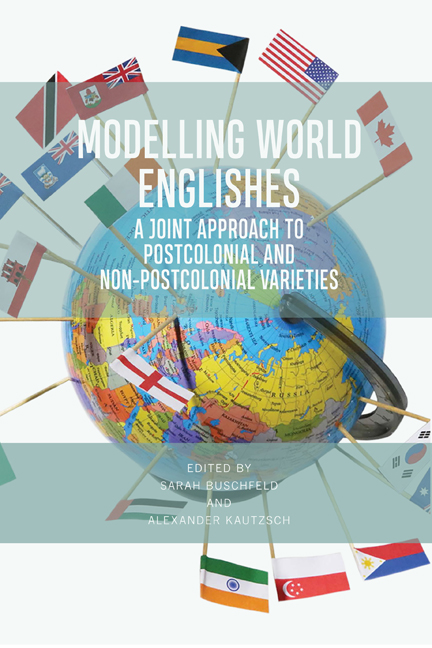Book contents
- Frontmatter
- Contents
- List of Figures and Tables
- List of Contributors
- Foreword
- 1 Introduction
- 2 English in England: The Parent Perspective
- 3 English in Namibia: Multilingualism and Ethnic Variation in the Extra- and Intra-territorial Forces Model
- 4 English in the United Arab Emirates: Status and Functions
- 5 English in India: Global Aspirations, Local Identities at the Grassroots
- 6 English in Singapore: Two Issues for the EIF Model
- 7 English in the Philippines: A Case of Rootedness and Routedness
- 8 English in South Korea: Applying the EIF Model
- 9 English in Japan: The Applicability of the EIF Model
- 10 English in Australia – Extra-territorial Influences
- 11 English in North America: Accounting for its Evolution
- 12 English in The Bahamas and Developmental Models of World Englishes: A Critical Analysis
- 13 Standard English in Trinidad: Multinormativity, Translocality, and Implications for the Dynamic Model and the EIF Model
- 14 Englishes in Tristan da Cunha, St Helena, Bermuda and the Falkland Islands: PCE, non-PCE or both? Blurred Boundaries in the Atlantic
- 15 English in Ireland: Intra-territorial Perspectives on Language Contact
- 16 English in Gibraltar: Applying the EIF Model to English in Non-Postcolonial Overseas Territories
- 17 English in Ghana: Extra- and Intra-territorial Forces in a Developmental Perspective
- 18 Synopsis: Fine-tuning the EIF Model
- Index
15 - English in Ireland: Intra-territorial Perspectives on Language Contact
Published online by Cambridge University Press: 24 September 2020
- Frontmatter
- Contents
- List of Figures and Tables
- List of Contributors
- Foreword
- 1 Introduction
- 2 English in England: The Parent Perspective
- 3 English in Namibia: Multilingualism and Ethnic Variation in the Extra- and Intra-territorial Forces Model
- 4 English in the United Arab Emirates: Status and Functions
- 5 English in India: Global Aspirations, Local Identities at the Grassroots
- 6 English in Singapore: Two Issues for the EIF Model
- 7 English in the Philippines: A Case of Rootedness and Routedness
- 8 English in South Korea: Applying the EIF Model
- 9 English in Japan: The Applicability of the EIF Model
- 10 English in Australia – Extra-territorial Influences
- 11 English in North America: Accounting for its Evolution
- 12 English in The Bahamas and Developmental Models of World Englishes: A Critical Analysis
- 13 Standard English in Trinidad: Multinormativity, Translocality, and Implications for the Dynamic Model and the EIF Model
- 14 Englishes in Tristan da Cunha, St Helena, Bermuda and the Falkland Islands: PCE, non-PCE or both? Blurred Boundaries in the Atlantic
- 15 English in Ireland: Intra-territorial Perspectives on Language Contact
- 16 English in Gibraltar: Applying the EIF Model to English in Non-Postcolonial Overseas Territories
- 17 English in Ghana: Extra- and Intra-territorial Forces in a Developmental Perspective
- 18 Synopsis: Fine-tuning the EIF Model
- Index
Summary
INTRODUCTION
Theoretically, contemporary Ireland is a bilingual country in which Irish is the first official language and English has secondary status. Practically, English is the dominant language, and Irish is a minority language that has first-language status for a small number of the population only and is acquired in school like a foreign language by the majority of children in Ireland. However, the historical spread of the English language in Ireland is comparable to the spread of English in a number of countries in which English now has the role of a second language, and which can be called ‘Outer Circle’ countries of English language use (Kachru 1992). In Ireland, English colonial history started in the late twelfth century; Irish English thus is the oldest overseas variety of English (Kallen 2013: 1). The linguistic situation in Ireland may therefore provide an early example of the spread of English as a postcolonial language in line with Schneider's (2003, 2007) Dynamic Model. However, the rise of the English language, as observed during the late medieval and Early Modern period, has neither been straightforward nor uncontested until the establishment of the language accelerates during the nineteenth century (cf. Hickey 2007; Kallen 2013: 1).
Considering the applicability of the Dynamic Model to the development of medieval language in Ireland, Ronan (2017) found that the development of English in Ireland in the medieval and Early Modern period are not yet fully explicable by the model. The current study elaborates on and extends the discussion beyond the early period. It aims to investigate in how far the spread of the English language in Ireland in this early period can be captured with by the modifications made to the Dynamic Model by the Extra- and Intra-Territorial Forces Model (Buschfeld and Kautzsch 2017). In order to do so, this study correlates socio-historical developments with linguistic features. Examples are taken from the Corpus of Irish English (Hickey 2002) for early materials and from the Ireland component of the International Corpus of English (Kallen and Kirk 2008) for contemporary data. These findings are then examined in the contexts of both Schneider's Dynamic Model and the Extra- and Intra-Territorial Forces Model (Buschfeld and Kautzsch 2017).
- Type
- Chapter
- Information
- Modelling World EnglishesA Joint Approach to Postcolonial and Non-Postcolonial Varieties, pp. 322 - 346Publisher: Edinburgh University PressPrint publication year: 2020



